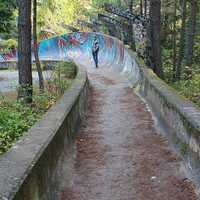Photo. Experienced the abonded bobsled track on the Trebević Mountain in Sarajevo. © Travel Explorations.
Took a cable car from the Sarajevo city near the City Hall. Soared in a cable car cabin towards the mountain peak. I moved through dense fog on the way up. It felt like slowly leaving one world and emerging into another. The fog wraps around the cabin and limited my visibility. Finally when I reached the top, I could see the views break through and a spectacular landscape revealed.
The start of the bobsled track was on a 1108 metres altitude at the Trebevic mountain and was over 1300 metres long. Walking along the Sarajevo bobsleigh track was an intense and evocative experience. The track, now abandoned and covered with graffiti, stands as a vivid reminder of both Sarajevo’s Olympic glory and the scars left by war.
The feeling to walk there was mixed - it gave me a strong reflections about the competition and at same time what happened afterwards. The track represents a stark contrast between the hope and unity of the Olympics and the brutal reality of conflict. As I walked down the twisted concrete curves, it’s almost surreal to think that athletes once sped through here, watched by cheering fans, only for it to later become a frontline for warfare.
The 1984 Winter Olympics in Sarajevo, Yugoslavia - now Bosnia and Herzegovina, was memorable, especially for its bobsleigh competitions. This was the first time that a Winter Olympics was held in a communist country, and Sarajevo delivered a remarkable experience despite economic and infrastructural challenges.
The bobsleigh competitions were held at the Trebević Mountain, where an impressive bobsled and luge track was built. The track was a modern marvel at the time, featuring 13 curves over a 1,300-meter stretch and a vertical drop that made it challenging and exciting. The track required extensive planning and construction, reflecting the host city's dedication to a high-quality Olympic experience.
After the 1984 Winter Olympics, Sarajevo and its Olympic infrastructure initially enjoyed a period of local pride and modest tourism growth. However, only eight years later, in 1992, the city and its Olympic sites were thrust into the devastating Bosnian War (1992–1995), which drastically changed the fate of Sarajevo and its once-celebrated Olympic legacy.
During the Siege of Sarajevo, the city’s Olympic venues became part of the front lines. Many venues, including the bobsleigh and luge track on Trebević Mountain, suffered significant damage from shelling and sniper fire. The bobsleigh track was repurposed by Bosnian Serb forces as a defensive position and artillery site, marking a dark turn for the structure built to celebrate international unity.
Many of the city’s Olympic facilities were damaged or destroyed during the war. For instance, the Zetra Ice Rink, which hosted figure skating and ice hockey events, was hit by artillery fire. Buildings, hotels, and even infrastructure like roads and bridges around Sarajevo saw heavy damage, leaving much of the city in ruin by the end of the conflict.
I also took my time to enjoy the breathtaking panoramic views of Sarajevo and its surrounding landscapes.
The bobsleigh track today is both a memorial and an artistic space that captures Sarajevo’s complex story. It serves as a reminder of the city's strength, the joy of its Olympic past, and the pain of its wartime suffering.
Stein Morten Lund, November 2024












